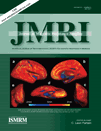On the use of a spin-echo based double inversion recovery acquisition for the measurement of cortical brain thickness
Abstract
Purpose:
To determine whether a spin-echo-based sequence, which are inherently insensitive to magnetic field inhomogeneity, can be used for brain cortical thickness measurement studies.
Materials and Methods:
By using a double inversion recovery (DIR) spin-echo-based sequence, cortical thickness estimates were performed from data acquired from seven healthy volunteers. The cortical thickness was also calculated from data acquired using an MPRAGE sequence and the Bland-Altman analysis was performed for comparison of the two methods. The average signal and contrast to noise ratios (SNR, CNR) of the two methods were also calculated.
Results:
The bias over the entire brain between DIR and MPRAGE was 0.87 ± 0.08 mm. The bias calculated in the major regional lobes were temporal: 0.76 ± 0.09 mm, frontal: 0.89 ± 0.07 mm, parietal: 0.92 ± 0.10 mm, occipital: 0.75 ± 0.12 mm, and cingulate: 0.79 ± 0.10 mm. This thickness difference was due mainly to the boundary difference in the MPRAGE and DIR at the grey matter/cerebral spinal fluid (GM/CSF) regions. The mean SNR and CNR was CNRMPRAGE = 47.8 ± 8.4 and CNRDIR = 19.2 ± 2.9, SNRMPRAGE = 76.8 ± 10.5 and SNRDIR = 21.1 ± 2.8.
Conclusion:
The study suggests that cortical thickness measurements can be performed using a DIR spin-echo sequence, which is inherently immune to main field inhomogeneity. Larger thickness measurements were consistently observed in DIR compared with MPRAGE. J. Magn. Reson. Imaging 2011;33:1218–1223. © 2011 Wiley-Liss, Inc.




